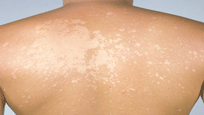Fungal Infection On Skin And Treatment
Fungal Infection On Skin And Treatment
 |
| fungal infection on skin |
Having clean and smooth skin is a dream for everyone, especially women. Having clean and clear skin is often associated with beauty and hygiene indicator levels.
Having clean and clear skin is not easy. Many factors can contribute to your skin health, including fungal infection problems. The words fungi here refer to the microorganism that infects human skin.
There are many types of fungal skin infections. If you are curious about a fungal infection on the skin, please continue to read this article.
Fungal Infection On Skin
Many people are getting skin infections without knowing that they get infected. Mostly, fungi infections are easy to spread between humans to humans. It generally spreads from skin to skin, with close contact or simply touching infected objects or animals.
Following are some types of fungal infections on the skin:
1. Ringworm
 |
| fungal infection on the skin - ringworm |
One of the common fungal infections on the skin is ringworm. Ringworm is characterized by the appearance of pink or red round rashes.
According to research, around 40 types of different fungi species can cause ringworm. The most common fungi that infect human skin are Microsporum, Epidermophyton, and Trichophyton.
How to treat ringworm
In some cases, ringworm can be treated using over-the-counter antifungal cream that you can get from your local drugstore.
However, if you find out the rapid spread and unbearable itchiness, please consult with your doctor immediately.
2. Tinea Versicolor
 |
| fungal infection tinea versicolor |
This infection is caused by Malassezia furfur that overgrowth on your body. This type of infection can appear in anybody, including the back, neck, chest, face, and upper arms.
Tinea versicolor will getting worse if you get sun exposure under humid and hot weather.
How to treat Tinea Versicolor
Infection by this fungus needs to be treated immediately because it quickly spreads all over the body and causes itchiness when the body releases the sweat.
However, you can't get rid of this fungus 100 percent because this type of fungi is a part of the natural important ecosystem on your skin.
The most common method to cure the overgrown tinea versicolor is using antifungal cream, soap, or antifungal lotions.
3. Tinea Cruris or Jock Itch
 |
| fungal skin infection - jock itch |
The characteristics of tinea cruris are itchy and red rashes with the shape of a ring. It often infects the thigh and groin area.
Jock itch often infects overweight people who sweat a lot and people who wear tight clothes. This type of infection will not cause serious effects but is still bothersome due to the itchiness it causes.
How to treat Tinea Cruris or Jock Itch
Treating tinea cruris are pretty simple,
- Always clean and dry your tight groin area
- Wear loose clothes, and make sure your skin can breath
- Don't forget to apply topical antifungal cream medication to the skin infected area
4. Toenail fungus
 |
| toenail fungus infection |
Another fungal infection that often occurs is toenail fungus. Many types of fungus can cause toenail infection, but the most common is white superficial onychomycosis, candida onychomycosis, and subungual onychomycosis.
How to treat toenail fungus
- White vinegar
- Tea tree oil
- Oregano oil
- Listerine
- Olive leaf extract
Post a Comment for " Fungal Infection On Skin And Treatment"